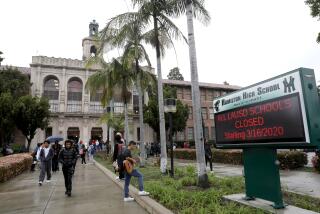Britton Asks Year-Round Status for All L.A. Schools : Education: School board to vote Monday on controversial anti-crowding proposal that would affect each public school student by 1991.
- Share via
All schools in the Los Angeles Unified School District will operate on a year-round basis by next year if the school board approves the overcrowding relief plan presented Monday by Supt. Leonard Britton.
The plan reduces from three to two years the proposed timetable for converting the district to year-round, partially in response to parents’ complaints that last month’s staff proposal phased schools into such an operation too haphazardly, causing problems for families with children in different schools and outside programs that serve students.
Under the new plan, scheduled for a vote by the board next Monday, schools would operate on the so-called 90/30 calendar, which puts students in school for three months, followed by one-month vacations. It is similar to a traditional calendar, but provides a shorter summer vacation and a one-month spring break.
In presenting the plan, Britton left no doubt that the 612,000-student district--the nation’s second largest--is moving toward multi-track, year-round operation.
“There is no question that a year-round, multi-track system is eventually what all schools have to be engaged in,” he told the board. “It is not a question of ‘if’.”
Initially, schools could choose either multi-track, which divides the student body into several groups and creates about 30% more space, because one group is on vacation at all times, or single track, with all students attending on the same schedule.
Single track does not create more space, but would allow neighborhood services, such as child care and camps, to conform and make it easier to add tracks if enrollment grew.
Single-track schools would have to add other options, such as larger classes or more portable classrooms, to increase capacity under the plan.
The district already has more than 100 year-round schools--the vast majority of them operating multi-track to relieve overcrowding so severe that it must bus students to other less-crowded schools.
Under the current proposal, 109 additional elementary schools would either go year-round or hold classes in double sessions beginning this summer. The rest of the district’s schools--including junior and senior highs--would go year-round beginning in July, 1991.
The district is not likely to be able to air condition all the year-round schools--a primary concern of many parents, especially in the San Fernando Valley where summer temperatures often exceed 100 degrees--because state funds set aside to pay some of the approximately $1 million cost per school were recently diverted to other projects.
The board agreed to delay discussion of the controversial proposal until it votes Monday. But the panel peppered Britton and staff with almost two hours of questions, demonstrating deep divisions among board members on how, and indeed whether, the district should take such a drastic step.
The board came to the brink of converting the district to year-round schedules two years ago, then backed off in the face of parental opposition.
This year, the district faces a literal shortfall of seats by next fall if enrollment continues to grow as it did this year--by more than 15,000 students.
“Space is rapidly disappearing,” Britton told the board Monday. “All schools must participate in the solution.”
In addition to recommending year-round operation, Britton’s report proposed other space-creating measures, including:
* The reconfiguration of schools feeding into Gardena and Verdugo high schools so that elementary schools would provide kindergarten through fifth grade; junior highs would provide sixth through eighth grades, and high schools would include ninth through 12th, beginning next school year.
* The reopening of Burton Elementary, one of 21 closed schools in the San Fernando Valley, as a receiver school for children from nearby overcrowded schools.
To improve the educational environmental at current multi-track year-round schools, Britton also recommended that those schools slightly reduce their enrollment and that a pilot project be tried in three of the district’s largest year-round schools--those with more than 2,000 students each--allowing each track to operate almost as a separate school.
More to Read
Sign up for Essential California
The most important California stories and recommendations in your inbox every morning.
You may occasionally receive promotional content from the Los Angeles Times.













